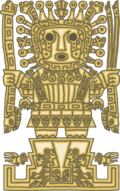Sapa Inka
| Sapa Inka of Kayahallpa | |
|---|---|
| Sapan Inka Musuq Kayamuchapa (1818-1926) Sapan Inka Kayahallpa (1926-1956) | |
Imperial | |
 | |
| Incumbent | |
| Kuntur Rimachi since 24 March 2022 | |
| Details | |
| Style | His Majesty |
| First monarch | Nyawpa |
| Last monarch | Tupaq Yupanki III |
| Formation | 1365 CE |
| Abolition | 14 May 1956 |
| Residence | Qhapaq Pikchu |
| Pretender(s) | 14 individual claims |
| Website | inka.ky |
The Sapa Inka (Sapan Inka, also known as the Emperor of Kayahallpa) was the monarchial head of state of Kayahallpa between 1818 and 1956, with the political history of the family itself (the Qhapaq Dynasty) stretching back to the 14th century, when they ruled over the antecedent New Kayamuchan empire. The first to hold the title of Sapa Inka was the semi-legendary Nyawpa, who is traditionally held to be the divine son of the god Wiraqucha. The last Sapa Inka to hold the throne was Tupaq Yupanki III, coronated in 1953 and overthrown three years later in the 14 May Coup, when a socialist republic was established by Kaman Yashakphi and the Kayan Workers' Party. Tupaq Yupanki died in 2022, and the right to the throne was handed over to his third eldest son Kuntur Rimachi.
The modern line originated from Kayaic tribal chiefs sometime in the 12th century in the hinterlands of the Kayamuca Empire before they migrated to the Warisuyu (modern Kayahallpa) in the early 1300s. Nyawpa would then establish the Qichwa Kingdom in Q'umir Suyu near north-eastern Wari in 1365. In 1434 they seized Tupawasi, the most prosperous of the Warian cities, and proclaimed the Musuq Kayamucha ("New Kayamuca") and soon controlled a massive empire covering the modern boundaries of Kayahallpa. This state collapsed in the 17th century due to the political and economic rise of the Mutul, ceasing to exist in reality somewhere between 1631 and 1636, with the Qhapaq Dynasty's claims to power and divine authority only entertained as a polite fiction. The Sapa Inkas and the Qhapaq house would have a stunning return to fortunes in the form of Tupaq Churan's conquests in the 1799-1818 Kayahallpan Resurgence, almost two whole centuries after their initial downfall, which brought all of modern-day Kayahallpa and even parts of the southern Mutul under the dynasty's direct control.